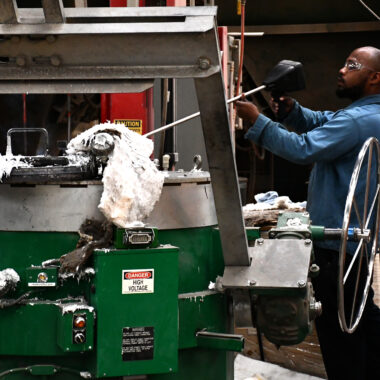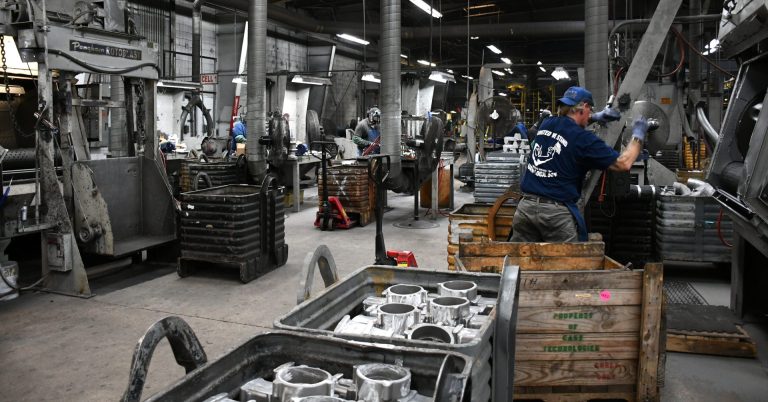Aluminum Casting Proficiency: Approaches to Raise Your Manufacturing Refine
Aluminum Casting Proficiency: Approaches to Raise Your Manufacturing Refine
Blog Article
Dive Into the World of Aluminum Casting: Understanding the Various Methods
Aluminum spreading is a fundamental process in the production market, with various techniques utilized to develop intricate and precise components. From the typical sand spreading method to the innovative die spreading process, each method offers distinct benefits depending on the demands of the project.
Sand Spreading Approach
Sand spreading, a widely-used method in aluminum casting procedures, entails developing mold and mildews made of compacted sand for putting molten steel. This technique is affordable and highly flexible, making it a preferred option for different industries. The procedure starts with the production of a pattern, generally constructed from wood or metal, which is then pushed right into the sand to leave a perception. The sand blend, normally silica sand blended with a binder like clay, is snugly loaded around the pattern to develop a mold and mildew cavity. Once the mold prepares, it is firmly put in a flask and molten light weight aluminum is put into the cavity.
After the metal has actually cooled down and solidified, the sand mold is escaped to disclose the aluminum spreading. Sand spreading permits the production of intricate shapes and big parts that might be hard or costly to generate making use of various other methods. It is likewise a lasting method as the sand can be reused and utilized multiple times, lowering waste in the casting process.
Irreversible Mold And Mildew Method

One significant benefit of the Irreversible Mold Method is the boosted dimensional accuracy it uses. The metal mold permits tighter tolerances and finer information in the last light weight aluminum spreadings contrasted to sand casting techniques. This precision makes it a recommended selection for applications where limited dimensional control is essential, such as in the auto and aerospace sectors.

Pass Away Casting Process

Investment Casting Technique
Making use of an accuracy spreading method, Financial investment Casting Approach includes developing complex light weight aluminum components by pouring molten steel into a ceramic mold and mildew. This procedure, also referred to as lost-wax casting, begins with the development of a wax pattern of the preferred component. This wax pattern is then coated with a ceramic product to develop a shell. Once the ceramic covering is set, it is heated up to eliminate the wax, leaving a hollow ceramic mold and mildew.
Investment spreading is frequently made use of for making elements in sectors where intricate layouts and limited tolerances are required, such as aerospace, automobile, and clinical devices. The adaptability and accuracy of the Financial investment Casting Technique make it a valuable method in the world of aluminum spreading.
Lost Foam Casting Approach
Having explored the go to website intricate precision of Financial investment Casting Technique, the focus currently shifts to the cutting-edge method of Lost Foam Spreading in light weight aluminum element manufacturing. Lost Foam Casting, likewise understood as evaporative pattern casting, is a modern-day technique where a foam pattern of the desired part is developed and then covered with a refractory material.
One of the major advantages of Lost Foam Spreading is its capability to generate complicated forms with intricate details, usually in a single piece without the requirement for additional machining. This technique is also understood for its high dimensional precision and smooth surface finish. Additionally, Lost Foam Spreading is an economical process as it decreases the demand for cores and enables for the manufacturing of lightweight elements. Regardless of its benefits, Lost Foam Spreading requires careful control of the spreading process to protect against problems and make certain high quality parts.
Verdict
To conclude, light check this weight aluminum casting provides a variety of techniques such as sand casting, permanent mold and mildew technique, die spreading, financial investment spreading, and lost foam casting. Each technique has its very own advantages and applications, making light weight aluminum casting a flexible and extensively used procedure in numerous sectors. Understanding the distinctions between these methods is crucial in selecting the most ideal spreading strategy for particular manufacturing requirements.
Sand casting, a widely-used approach in aluminum spreading processes, entails creating molds made of compacted sand for pouring molten steel. aluminum casting.The Irreversible Mold Strategy, like sand casting, is one more prevalent technique utilized in aluminum casting procedures, supplying distinct benefits in terms of mold and mildew reusability and dimensional accuracy. The metal mold and mildew enables for tighter tolerances and better information in the final light weight aluminum spreadings compared to sand casting techniques. The 2 primary types of die spreading are chilly chamber die casting and hot chamber die casting, each suitable for various types of aluminum alloys.In conclusion, aluminum spreading uses a selection of approaches such as sand spreading, long-term mold method, die spreading, investment casting, and lost foam casting
Report this page